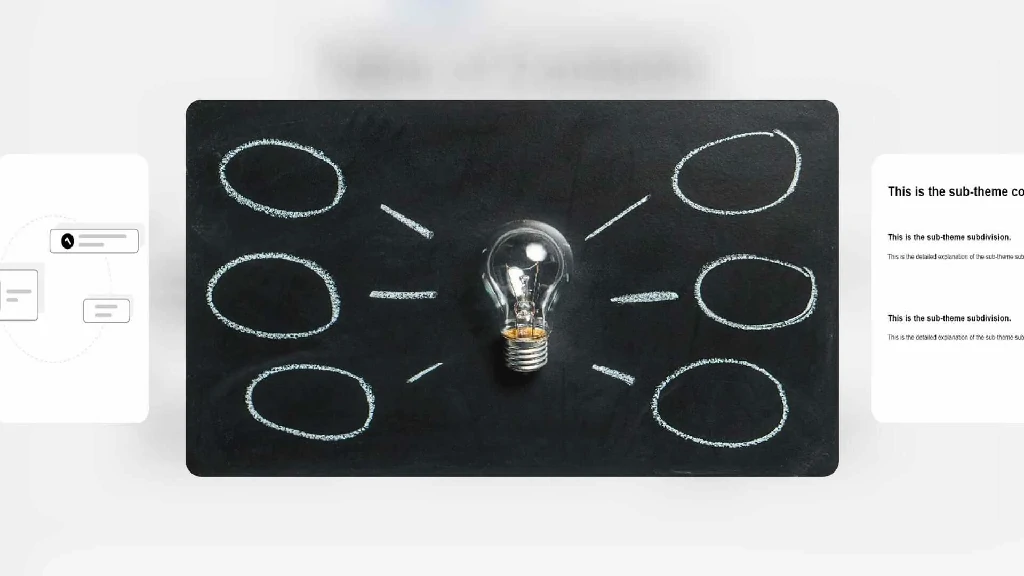
Presentation rules provide valuable guidelines for creating engaging and effective presentations. These rules encompass principles such as clarity, brevity, and audience engagement to improve communication effectiveness. Common rules include the 10-20-30 rule, which advocates for concise content; the 1-6-6 rule, which emphasizes simplicity; and the 3E rule, which focuses on content and audience. By following these rules, presenters can deliver presentations that capture the audience's attention, clearly communicate key messages, and inspire action. Ultimately, presentation rules serve as essential tools for creating powerful presentations that resonate with audiences and achieve communication goals. In this text, we will examine the 10-20-30 Rule, 1-6-6 Rule, 5-5-5 Rule, 15-30-45 Rule, and 3E Rule.
The 10-20-30 Rule
1.Definition:
10 slides: There should be no more than ten slides. What is important in a presentation is what the speaker says. The presentation is just an aid. Every time you show slides on the screen, the audience's attention shifts: from what you are saying to the screen. If you keep showing slides, the more distracted the audience becomes. And the more slides you have, the more points you are likely to make.
20 minutes: The time of presentation should not longer than 20 minutes. Most people's attention spans only last a short time, and we can only focus on a topic for so long. When presenting, limiting time to 20 minutes is a better standard. Too much time leads to verbosity and too much non-essential information. Too little time means that key information may not be conveyed and the topic may not be obvious.
30 Point size: Fonts should not be smaller than size 30 In a slide show, the larger the font, the fewer the words, and the better it is to grab your audience's attention. This forces you to aim for clarity and brevity. If there are too many words, the audience will focus on the slides and not be able to concentrate on the speaker's presentation.
2.Origin
The 10-20-30 Rule in presentations was generated by Guy Kawasaki, a renowned entrepreneur, author, and venture capitalist. This rule is often used as a guideline for creating concise, focused, and engaging presentations that effectively convey key information without overwhelming the audience with too much detail.

Kawasaki first introduced the 10-20-30 Rule in 2005 on his blog, and later discussed it in his 2004 book, The Art of the Start. He drew this rule from his own experience as a speaker and listener, recognizing the need for presentations to be concise, clear, and visually appealing, especially in the fast-paced world of entrepreneurship and business pitching.
3.Function
The 10-20-30 Rule encourages presenters to focus on essential content, preventing information overload and ensuring clarity. Its constraint promotes brevity and keeps the presentation engaging, respecting the audience's attention span. It also ensures that key points are easily visible even from a distance. Collectively, these functions help presenters craft concise, impactful presentations that effectively convey their message, engage the audience, and leave a lasting impression.
The rule's simplicity and effectiveness has led to its widespread adoption across a wide range of industries as an essential guide for speakers to deliver impactful presentations that capture and hold the attention of the audience while effectively delivering key messages.
The 1-6-6 Rules
1.Definition
1 main ideas: One main idea principle means that each slide conveys the same concept or message. This main idea serves as the focal point around which the entire slide content revolves. By limiting each slide to one main idea, presenters can maintain clarity, focus, and coherence in their presentations, making it easier for the audience to understand and retain the key message.
6 bullet points: No more than six bullet points per slide. This recommendation aims to maintain clarity and focus within the presentation by avoiding overcrowding slides with excessive information. Having no more than six bullet points per slide helps ensure that each point receives adequate attention from the audience. It also encourages presenters to prioritize the most important information and avoid overwhelming viewers with too much detail.
6 words per bullet point: This means that each point cannot be expressed in more than six words. This way can encourage concise and have an impactful communication. For examples, when one of your slides is talk about “Benefits of work hard”, your bullet point can be “gain money” and “improve professional capability”.
2.Origin
The 1-6-6 presentation rule probably emerged as a response to the need for concise and impactful presentations, and it is likely stemmed from cognitive science research. While its precise origin is not definitively documented, it likely evolved from a combination of communication principles and practical experience in public speaking and presentation design.
One potential influence is the broader movement towards minimalist design and communication clarity, which gained momentum in the late 20th and early 21st centuries. As technology advanced and attention spans decreased, presenters sought methods to streamline their message delivery and improve audience engagement.
3.Function
The 1-6-6 Rule in presentations serves several critical functions. By limiting each slide to one main idea and six bullet points with six words or fewer per point, it promotes clarity, conciseness, and audience engagement. This rule encourages presenters to distill complex concepts into easily digestible chunks, enhancing comprehension and retention. Additionally, it helps prevent overcrowded slides and information overload, ensuring that key points stand out and resonate with the audience. Ultimately, the 1-6-6 rule facilitates effective communication, allowing presenters to deliver their message with precision and impact, while keeping the audience focused and attentive throughout the presentation.
The 5-5-5 Rule
1.Definition
5 lines of text: When we create a slide show, there should not be too much text content. Putting too much information on a slide can lead to too much information and distract the audience. Limiting the number of lines on a slide effectively distills key information and focuses the audience's attention on the main message.
5 words in each line: Slides cannot have more than 5 words per line. When creating a slide template, readability must be prioritized. Limiting the number of words per line to 5 ensures that the text is easy to read and understand, even from a distance.
5 text-heavy slides: No more than 5 slides with too much information. This rule is also a limitation to prevent slides with too much information from distracting the audience. By limiting the number of consecutive slides with text to five, you can increase the use of visuals, multimedia, and other forms of content that can help maintain interest and enhance understanding.
2.Origin
The 5-5-5 presentation rule has emerged as a pragmatic guideline in the realm of concise and impactful communication. Like the 1-6-6 Rule, although its exact origin is not definitively documented, it likely evolved from the collective wisdom of presentation experts and public speakers seeking to streamline message delivery while maintaining audience engagement.

This rule is a response to the challenges of capturing and retaining audience attention in an era of shortened attention spans and information overload. By distilling presentations into a limited number of slides, each containing a succinct narrative conveyed through a small number of sentences, presenters can focus on conveying essential information and compelling storytelling.
3.Function
The 5-5-5 Rule in presentations is a guideline aimed at enhancing clarity, brevity, and impact. It suggests using no more than 5 words per bullet point, 5 bullet points per slide, and 5 text-heavy slides. It encourages presenters to distill complex ideas into concise, easily digestible points, improving audience comprehension. Then, it prevents overcrowding on slides, ensuring that visual elements remain clear and uncluttered. Finally, by limiting the time spent on each slide, it maintains audience engagement and prevents boredom, fostering a dynamic and effective presentation environment.
The 15-30-45 Rule
1.Definition
15 minutes: This refers to presentations that are 15 minutes or less. The timing of a speech is a quest for appropriateness. Too long or too short is not good. Most people stay focused on one thing for about 15 minutes or so. So, keeping your presentation under 15 minutes is appropriate.
30 slides: Keep the number of slides used in your presentation to 30 or less. Unlike the 10-20-30 rule, the numbers here are more flexible, but it's usually recommended to have no more than 30 slides to make sure you don't overcrowd your presentation in a short period of time.
45 seconds: The average presentation time per slide is around 45 seconds. The time spent on each slide should be roughly equal to ensure that you maintain a consistent pace during your presentation. It is also easier to time your presentation.
2.Origin
As with the 1-6-6 Rule and the 5-5-5 Rule mentioned earlier, the 15-30-45 Rule is likely evolved from similar principles as other presentation guidelines—namely, the need for brevity, clarity, and audience engagement.
Presenters and communication experts recognized the importance of respecting audience attention spans and avoiding information overload. They observed that shorter presentations with fewer slides tend to be more engaging and effective in conveying key messages. Therefore, the 15-30-45 Rule emerged as a practical guideline to help presenters structure their presentations in a concise and impactful manner.
3.Function
The 15-30-45 Rule for PPT presentations is a guiding principle designed to help presenters create concise yet effective presentations within a time limit. The time limit helps presenters to organize their presentations efficiently and ensure that the main message is conveyed in the limited time available. Presenters also streamline their content and focus on the most critical information. An average presentation time of 45 seconds per slide requires presenters to design concise and clear slides to ensure that the audience has enough time to read and understand the content on each slide. In addition to this, presenters are better able to keep the audience's attention, making them more focused on the content of the presentation and increasing audience engagement and interaction.
The 3E Rule
1.Definition
Engage: When we give a presentation, we can capture the audience's attention with some compelling content. This could be a compelling story, an interesting statistic, a striking question, or an engaging image. This will be able to engage the audience at the beginning of the presentation and keep them interested in what is to come.
Explain: After engaging our audience, we need to explain our main point, message, or content. This may include explaining the benefits of our product or service, introducing a concept or theory, or sharing some data or case studies. Make sure our explanation is clear, concise, and presented in a way that your audience can easily understand.
Empower: Presentations should empower the audience to take actions. Columns include calling on them to take a specific action, providing resources for them to continue learning or participating, or motivating them to participate in a discussion or share their ideas. Make the audience feel that they can learn something from the demonstration and be able to apply that knowledge or idea in real life.
2.Origin
Different from the 10-20-30 Rule, the 3E Rule in presentations emerged as a structured framework to guide presenters in crafting more effective and impactful presentations. While there isn't a single documented origin for this rule, it reflects main principles of effective communication and storytelling that have been developed and refined over time.
3.Function
"Engage" attract audience attention with compelling beginning, ensuring sustained interest. "Explain" facilitates clear and concise delivery of main ideas, aiding audience comprehension. Through "Empower," presenters arouse action or application of presented information, fostering audience involvement. Overall, these functions create dynamic presentations that captivate, inform, and motivate audiences, facilitating better retention and application of content. By guiding presenters in crafting engaging narratives, providing clarity, and inspiring action, the 3E rule elevates the impact and effectiveness of presentations, ultimately enhancing communication outcomes.




